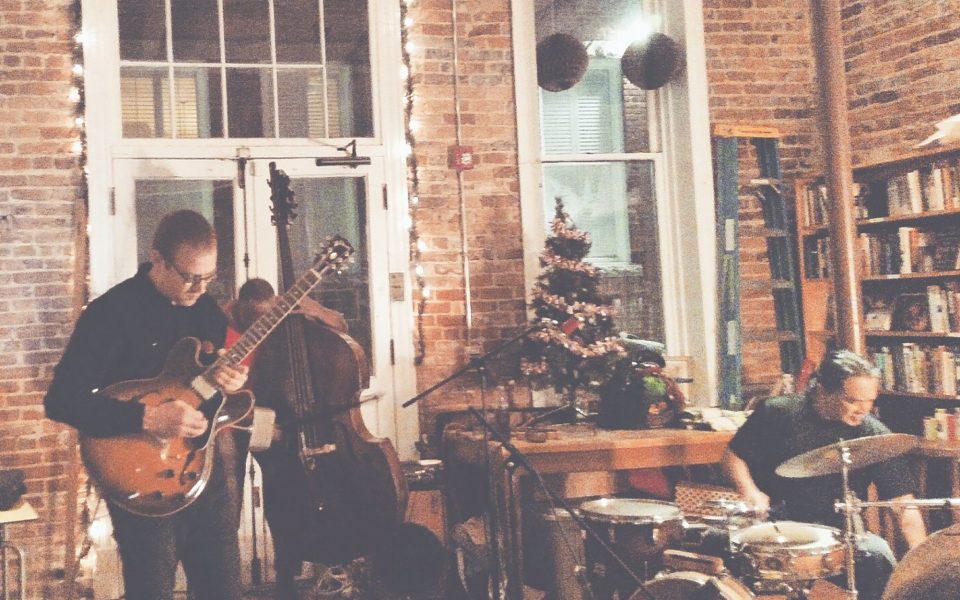You’ve never heard this music before. Or at least not this exactly. I’m sure you can summon numerous examples and artists who play similar styles and use the same techniques, but the music James Gilmore is making has never been heard before — not even by the guitarist himself.
The Greensboro-based jazz guitarist has made a name for himself as being one of the most prominent free-jazz musicians in the Triad. Having performed alongside dozens of top musicians and constantly playing shows, Gilmore seems to make it a point to keep the spaces around him occupied by new musicians. With an ever-changing, collaborating lineup, Gilmore’s music achieves a level of sound that is as transitory and ebbing as a river.
Accompanying Gilmore at Scuppernong Books in Greensboro on Nov. 29 were bassist Vattel Cherry and world-renowned Japanese percussionist Tatsuya Nakatani; Cherry having performed with Gilmore on numerous occasions, though this was the first time they played with Nakatani. But the trio were natural collaborators, whose styles came to blend perfectly.
Out of nowhere, the sounds began with fine strings of Nakatani’s long, handmade bow pulling across brass hand bells. The high tones of the bells sounded like a human voice, singing out into the far corners of the room, drifting off among the wooden bookshelves that lined the walls on all sides of the stage. As Nakatani started the show, moving from hand bells to gong, pulling various sized bows across the metal, Gilmore stood with his eyes closed, listening patiently, as if waiting for the music to invite him into the song.
Just beneath the high, brass bellows of the bells came Vattel Cherry’s rhythm pulsing in the background. With Cameroonian leg rattles tied around each ankle, Cherry moved his feet in syncopated timing to the highs and lows of the bells. His fingers scrapped along the bass strings, hands slapped the honey-colored wood, and the room suddenly burst to life as Gilmore jumped into a melody and joined in.
While jazz was the backbone to the music these men were making, the performance contained an ever-present avant-garde element, allowing for any of the musicians to break free from whatever tune they were in, and carry the music into entirely different realms. Everything that was played relied on improvisation. The music held tones and moments that built and rose louder and louder like rising water, leading you to feel panic amid the music; however, other moments were soft, nearly inaudible as the musicians found perfect synchronicity in their dynamics.
This style of free jazz and unorthodox, experimental music has had plenty of advocates in the last half-century. Artists like John Zorn, Masada and Naked City have all explored the realms of improv and pushed jazz to the furthest fringes to see what might happen.
The beauty of the approach is that during each performance, something completely and utterly new is created. The instruments become conduits to the musicians as they listen, feeling the moments, as if each instrument, each performer is in conversation with the others, speaking now, then listening, next laughing together. The music created is pure, condensed, raw sounds that, somehow, find a harmony that draws immediate emotion from any listener.
Appreciating Gilmore’s music definitely requires a certain disposition and openness, especially for those who are unfamiliar with the style. At times, it felt as if the musicians were suddenly engrossed in pure self-gratification and were too much in love with the sounds they were making — a hazard for any musician. The music reached moments of pure chaos and dissonance at times, giving aid to the notion that perhaps the musicians don’t care about those listening in the room, but would rather carry on. It’s a hard line for any musician to cross. Though for many, the point of avant-garde music is to free musicians from the burden of worrying about whether the audience is enjoying it. The question, though, becomes whether or not to care about your audience, of when the musicians become too engrossed in themselves and at what point must they give homage to those gathered to listen.
Experimental jazz lends itself to more difficult listening, perhaps more so than most genres. But even then, there was a world of sound being examined throughout the show, which is enticing. The musicians found new ways to make music and tones that are full of twists and surprises and that’s something many artists aim to accomplish but fail to achieve.
Towards the end of the night, Nakatani and Cherry each pulled their stringed bows across their instruments, Gilmore’s guitar reverberated and let out a wail of controlled feedback as he thumped his fist on the headstock, and the music drifted off into the far corners of the room. Everyone sat perfectly still as the music dissipated, as if drifting off to some other place, some other instrument. Everything was suddenly silent. And just like that, plucked out from nowhere at all the music had begun, and vanished like a cloud of smoke.
You’ve never heard this music before. No one will ever hear it again.
Join the First Amendment Society, a membership that goes directly to funding TCB‘s newsroom.
We believe that reporting can save the world.
The TCB First Amendment Society recognizes the vital role of a free, unfettered press with a bundling of local experiences designed to build community, and unique engagements with our newsroom that will help you understand, and shape, local journalism’s critical role in uplifting the people in our cities.
All revenue goes directly into the newsroom as reporters’ salaries and freelance commissions.


Leave a Reply